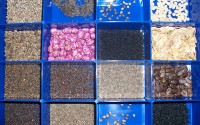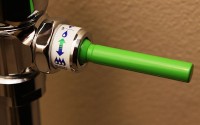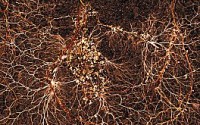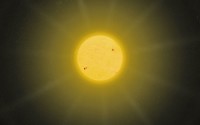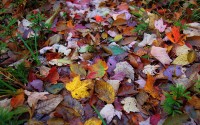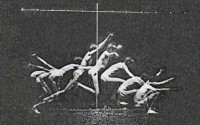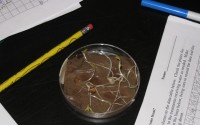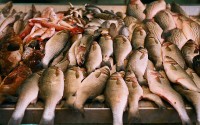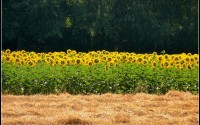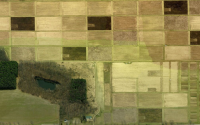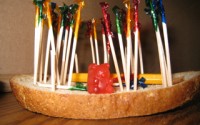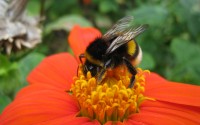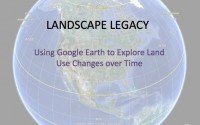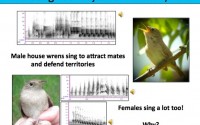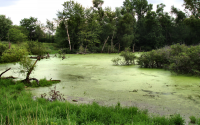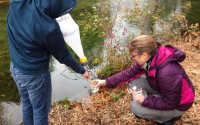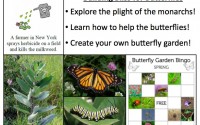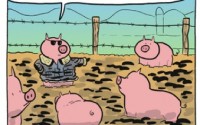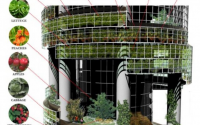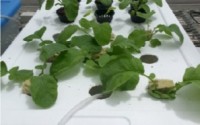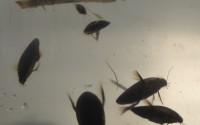Ever wonder how biologists reconstruct ancient human migrations? Or, how a paternity test works? It’s all in the genes, folks! Our session will focus on the many practical applications of molecular biology. Building on the Lady Beetle Blitz session, we’ll describe variation in field collected beetles, categorizing them based on phenotype, and then use molecular tools to reconstruct their North American Invasion in the late 1980s. At the conclusion of the lesson, students will be able to: Describe the diversity of a population in terms of phenotype and genotype. Use genotypic information to answer questions about the migration of a species. Use genotypic information to answer evolutionary questions about organisms. Resources: Lesson plan (.doc) Handouts: Phenotype and genotype comparison (.doc) Genetic sequences (.doc) Lady beetle intro sequences (.doc) Mitochondrial DNA data and questions (.doc) (optional extension) Lesson Plan created by GK-12 Partners Robin Tinghitella and […]
Succession: patterns in the field and in seeds
This lesson will review what the students already know about succession, then develop their understanding of what may be driving the pattern. They will brainstorm hypotheses and predictions. They will walk the nature trail to practice recognizing different successional stages and to collect seeds from the plants in different stages. They will also think about seed dispersal and other plant adaptations. This lesson can be expanded to include a section where 10th grade students give 5th grade students a tour of the nature trail and teach them about succession. At the conclusion of the lesson, students will be able to: Recognize successional patterns in plant communities in the field Recognize seeds and the structures in which they occur; describe the dispersal adaptations of those plants Brainstorm hypotheses explaining succession and generate predictions Resources: Lesson plan (.doc) Presentation with background information (.pdf) Drawing […]
Conserving water and calculating your water footprint
Students will record their own water usage at their house for a week and estimate their daily water consumption. They will then be re-assigned to a different country where their water will be limited to the average usage of people in that location. The students will have to decide what they will use their allocation of water for, and then listen to how much other groups got to use and what they chose to use their water for. At the end, we will brainstorm why some locations have more water to use than others, and how that can lead to conflicts among different groups. At the conclusion of the lesson, students will be able to: Identify wasteful water practices Explain differences in water usages in different areas Understand the impact that water availability has on society Resources: Lesson plan (.doc) Presentation (.pdf) […]
Rotten, but not forgotten
Students often have misconceptions about the process of decomposition. Students often explain decomposition as a purely physical process. This introductory activity is meant to display the biochemical process of cellular respiration as it is occurring in microorganisms present in composting material. Cell respiration refers to the process of converting the chemical energy of organic molecules into a form immediately usable by organisms. Glucose may be oxidized completely if sufficient oxygen is available according to the following equation: C6H12O6 + 6O2 –> 6 H2O + 6 CO2 + energy All organisms oxidize glucose for energy. Often, this energy is used to convert ADP and phosphate into ATP. Using the CO2 Gas Sensor and O2 Gas Sensor, students will monitor the carbon dioxide produced and the oxygen consumed by bacterial and fungi during cell respiration. Resources: Activity plan using CO2 and O2 Vernier […]
Humans and Biodiversity
This lesson explores potential impacts that humans have on biodiversity as well as defining biodiversity, and exploring the potential positive impacts it has on humans and ecosystems. The lesson includes an outdoor activity consisting of choosing and visiting three sites that span a gradient of human impact. Using data collected during this activity, students will learn to use these data to calculate indexes of biodiversity. Some time will be spent discussing benefits/drawbacks to the methods employed. Data from the three sites will be compared to explore how humans tend to affect biodiversity. The topic of genetic biodiversity will also be covered with some examples where genetic diversity is important for humans and ecosystems. At the conclusion of the lesson, students will be able to: Assess levels of biodiversity in a given habitat Discuss benefits and drawbacks of different methods for […]
Invisible Friends Underground
In an inquiry-based activity, students will learn about mycorrhizal fungi and how to find them by collecting roots, staining them with ink and vinegar, and looking for fungi under the microscope. At the conclusion of this lesson, students will be able to: Use a microscope Prepare wet-mount samples Understand one example of a mutualistic interaction and how it can change depending on the environment Formulate research questions Make predictions about what will affect the abundance of a specific type of organism and collect data to test their predictions Make and interpret graphs of data Resources: Lesson plan (.doc) Introduction presentation (.pdf) Student worksheet (.doc) Photo sheet (.pdf) Lesson plan created by Emily Grman, 2012
Mycorrhizae: Mutualism or Parasitism?
Students will explore one example of a symbiosis (mycorrhizae) and examine whether it is a mutualism or a parasitism. They will review the life requirements of producers (plants) and consumers (mycorrhizal fungi) and play a game simulating trade between the two organisms in two different environments. At the conclusion of the lesson, students will be able to: Define symbiosis, mutualism, parasitism, consumer, producer Explain how plants and mycorrhizal fungi obtain their life requirements (air, food, water) Understand that changes in the environment, including changes caused by humans, can change the way organisms interact Resources: Lesson plan (.doc) Student worksheet (.doc) Answer key (.doc) Figures (.xls) Lesson created by Emily Grman, 2009
Albedo: How much of the sun’s energy gets absorbed?
Students will explore how different substances (air, water) and different colors absorb energy from the sun and warm up. We will discuss what we already know about light energy and absorption, make predictions about what color of background paper will cause air and water to heat up faster, test our predictions by constructing boxes and collecting temperature data, analyze our data, and make conclusions about the implications for climate change. At the conclusion of the lesson, students will be able to: Graph data and interpret graphs Draw conclusions from data collected during an experiment Understand that the energy that powers almost everything on the planet comes from the sun, and that different substances can absorb more or less of that energy Resources: Lesson plan (.doc) Presentation (.pdf) Student worksheet (.doc) Worksheet for 2nd try (.doc) Figures (.xls) Lesson created by Emily Grman, 2009
Into Thin Air: What happens to leaves when they decompose?
Middle school Students will expand on their understanding of carbon cycling by measuring the concentration of CO2 and O2 in sealed containers with decomposing leaves. Students will gain experience using the Vernier LabQuest system with two gas sensors. They will also graph data and use the data to evaluate their predictions about what will happen to the carbon inside leaves. At the conclusion of the lesson, students will be able to: Understand that most of a leaf’s mass goes into the air during decomposition Recognize the six major elements making up living tissue Understand why decomposition is a central step in carbon cycling. High school Students will expand on their understanding of carbon cycling and decomposition by measuring the concentration of CO2 over time in closed containers with decomposing materials. In Part 1, they will set up coffee cans in […]
Animal Motion
* This lesson provides a link between the Living Organisms and Movement Battle Creek Area Math and Science Center units. Students explore the different ways animals move and name body parts used for locomotion. They also explore plant movement (seed dispersal) and discuss the fact that plants need help moving (being pushed by wind or water) whereas animals can move themselves. At the conclusion of the lesson, students will be able to: Identify body parts commonly used for animal movement Recognize that plants move when they are seeds Discuss reasons why plants and animals might want to move Resources: Lesson plan (.doc) Lesson created by Emily Grman
Where does plant mass come from?
Students will learn the products and reactants of photosynthesis and respiration. They will generate a circular diagram showing the cycle of carbon through carbon dioxide and sugars (the hypothesis). They will generate predictions from this hypothesis that refer to specific treatments in the experiment they will set up. They will set up an experiment with germinating bean seeds in petri plates (with or without water, in the light or in the dark), collect data over two weeks, and analyze the results graphically and verbally. At the conclusion of the lesson, students will be able to: Explain that respiration causes the loss of dry biomass (sugars) Explain that photosynthesis causes the gain of dry biomass Understand that carbon (carbohydrates) from carbon dioxide in the atmosphere makes up most of the dry mass of plants. Resources: Lesson plan (.doc) Outline of activities (.doc) Pre-assessment (.doc) […]
To Fish or Not To Fish
Students explore sustainability of seafood consumption through modeling harvest rates in an Excel file and debating the relative costs and benefits of farmed vs. wild-caught fish. Provided with information on the various direct and indirect human impacts of both fishing and fish farming and assigned a position, teams of students will construct argument for their position and use data to support their conclusions. At the conclusion of the lesson, students will be able to: Understand that there are costs and benefits of human impacts and to provide examples of each. Understand and be able to describe the magnitude of human disturbances. Define environmental sustainability and make an argument for whether it should be an important consideration in our behavior. Resources: Lesson plan (.doc) Human impact in aquatic systems presentation (.pdf) Student worksheet (.doc) Exercise (.xls) Debate positions (.pdf) Debate ammunition (.pdf) Evaluation (.doc) Lesson created by GK-12 […]
Light and Plant Biomass
Tracing matter and energy through environmental ecosystems: in specific, how plant production of organic carbon (biomass) is related to availability of an essential resource for photosynthesis (light). Do taller plants produce more biomass than shorter plants? How are plant height and stem density related to the amount of light reaching the ground? At the conclusion of the lesson, students will be able to: measure plant biomass in relation to light availability at the soil surface examine soil and roots draw conclusions about how aboveground biomass, plant height, stem density, and light availability are related Resources: Lesson plan (.doc) Introduction (.pdf) Outline of lesson (.doc) Datasheet (.doc) Lesson created by Emily Grman and Sue Zygadlo, 2008
How Do Scientists Study Succession?
KBS scientists maintain 4 different types of successional plots: two get tilled every year and two have been undisturbed since 1988. One of the tilled and one of the untilled plot get fertilized with nitrogen, an important nutrient limiting plant growth, every year; the other two plots do not. Each year, scientists collect data on which plant species are there, how much they grow, and other characteristics of the plants. In this lesson, students will explore this data to learn about succession, human disturbance (tillage), plant traits, plant life history, and population growth. They will also gain scientific skills in graphing and math. At the conclusion of the lesson, students will be able to: Work with a real data set from the KBS LTER Understand how management regimes can influence communities Have a good understanding of using Microsoft Excel to […]
Forest of Fortune
Students explore the natural areas that are managed around Michigan (e.g. forests, lakes, rivers, prairies). Students will learn about the needs of the many interest groups that managers must satisfy when making a management plan. Students will then become National Forest managers of mini-stands in order to simulate the decisions that need to be made when creating a management plan and some of the unpredictable events that take place At the conclusion of the lesson, students will be able to: Name the types of natural areas that are managed in Michigan (and elsewhere) List examples of considerations (interest groups, funding, policy etc.) that managers need to satisfy when creating a management plan Describe the relationship between profitability and sustainability Discuss some techniques that are used for management of forests Resources: Lesson plan (.doc) Presentation (.pdf) Student worksheet (.doc) Student worksheet – elementary (.doc) World-view […]
What’s the Buzz?
Students will learn the common types of pollinators. They will then learn the characteristics of flowers that allow the flowers to attract and utilize particular pollinators. Students will then go outside to put their predictions to the test by observing plants and their pollinators. At the conclusion of the lesson, students will be able to: learn some of the common types of pollinators notice more details of plants with which they come into contact be able to predict what might pollinate each plant species learn that even though flowers look very different from one species to another, they still share some characteristics that allow them to be pollinated by similar types of pollinators Resources: Lesson plan (.doc) Presentation (.pdf) Worksheet (.doc) Lesson Plan created by GK-12 Fellow Raffica La Rosa, 2008
Bug Lyphe! A Next Generation-linked observational study in biodiversity
NGSS are about the art of teaching rather than just content expectations. In this lesson, we will teach an ecology lesson about biodiversity this particular way. Biodiversity is discussed in many objectives ranging from genetic variation, ecosystem dynamics, functioning and resilience, to interdependent relationships in habitats. We will capture insects, an activity related to the BEST plots biodiversity protocol, as a vehicle to discuss differences in biodiversity among natural and disturbed habitats. A follow up discussion in Landscape Restoration can be included. At the conclusion of the lesson, students will be able to: Define ecosystem and biodiversity Design and carry out standardized protocols for conducting biological surveys Use a simple dichotomous key to identify organisms Graph data and interpret results Resources: Lesson plan (.docx) Data Collection worksheet (.docx) Instructor presentation (.ppt) Class presentation (.ppt) Shannon Biodiversity Index Calculator (.xlxs) What […]
BEST plot Landscape Protocol: Landscape Legacy Application
Understanding the landscape surrounding our school districts, cities, and homes can help us understand how the landscape is impacting our local environment and watershed. This lesson uses the Google Earth application to gain a better understanding of how a parcel of land has changed through time. This exercise offers a unique opportunity for any classroom to take part in BEST plot research even if BEST plots are not present or accessible. At the conclusion of the lesson, students will be able to: Develop a better understanding of how the land surrounding the school district, or area of interest, has changed through time. Students will develop skills using Google Maps, reading maps and satellite images, and recognizing Michigan landscapes/landforms. Resources: Lesson plan Slideshow (.pdf) Land use categories (.pdf) Datasheet (.pdf) BEST plots landscape protocol (.pdf) Lesson Plan created by GK-12 Fellow […]
Chi-Square tests: When and how to use
Researchers often need to decide if the results they observe in an experiment are close enough to predicted theoretical results so that the tested hypothesis can be supported or rejected. For example, do a series of coin flips match what you’d expect to get by chance, or is their evidence the coin is unfair? Does the number of women interviewed for a job position match the proportion of women in the applicant pool, or is there evidence of bias? Does the number of white-eyed fruit fly offspring match the number expected if the white-eyed trait is recessive, or are white-eyes inherited in some other way? In this lesson, students will able to: Decide when it is appropriate to use a chi-square goodness-of-fit test Use a chi-square test, interpret the results, and create evidence-based conclusions Use a chi-square test on real […]
Wetlands: Not just a swampy place
Wetlands are a ubiquitous part of the southwestern Michigan landscape and provide numerous important ecological services. Wetlands allow water to slowly filter into the ground, which cleans water, provides a buffer against flooding, and re-charges groundwater supplies. They also provide habitat for many animal and plant species. Wetlands provide an opportunity for students to explore parts of the water cycle, food webs, and many other ecological processes. In this lesson, students learn about different types of wetlands and how they work through a series of presentations, games, and hands-on activities. At the conclusion of the lesson, students will be able to: Understand how wetlands affect water, wildlife, and ecological processes Understand how wetlands help prevent pollution and erosion Recognize that wetlands are complex systems that support many different forms of life, from top-predators to microscopic organisms Resources: Lesson plan Powerpoint (pdf) […]
Where the Wild Things Are: How Rainfall Drives Food Web Interactions
Every organism, large and small, is affected by weather. Some organisms like plants are affected directly by rainfall. Others are impacted through their food chain relationships. In the hot-dry tropics found in some parts of Africa, seasonal patterns of rainfall drive one of the most impressive animal migrations in the world. This activity uses the great African migration to review the water cycle and emphasize how food webs are strongly impacted by rainfall patterns through a hands-on activity. The food web portion of this exercise can be used independently as a hands-on alternative to pen-and-paper models to review food webs, food web vocabulary, or the importance of biodiversity in ecosystems. The food web exercise also contains additional scenarios that explore: 1. The importance of taking food webs and animal behavior into account when planning wildlife reserves, 2. How human-animal conflicts […]
What’s in My Backyard? Identifying Winter Birds in Michigan
Although winter may seem like a life-less frozen wasteland here in Michigan, many birds spend the winter here. Some arctic birds even come down to Michigan to escape the cold! Many of these winter birds can be easily attracted to backyard feeders, particularly since food is in short supply. In this lesson students will learn how to identify the 16 most common feeder birds in Michigan and will be introduced to 8 other less common species. Students will learn how scientists classify and identify species. This lesson also provides materials necessary for students to collect data from their own bird feeder and tools to contribute their data to citizen science efforts like the Great Backyard Bird Count or Cornell’s eBird tracking program that help scientists monitor bird populations across the United States. At the conclusion of the lesson, students will […]
Sex Changes, Drugs, and Rockin’ Dead Zones: A trifecta of lessons
This lesson consists of 3 activities, all interrelated yet can be split into individual lessons as well. The overall theme of the lessons are to investigate the effect human introduced contaminants into aquatic systems have on individual organisms, populations, communities, and ecosystems. We will investigate how farming in the “Bread Basket” of America can contribute to a growing “Dead Zone” in the Gulf of Mexico and then create our own dead zones in lab. Students can then become a participant in the formation of dead zones in an interactive simulation/game. The final component of the lesson focuses on investigating the effect a novel (or never before seen) contaminant has on vulnerable frog populations. At the conclusion of the lesson, students will be able to: Describe how a dead zone occurs – from the human sources of pollution to how it […]
Building Bliss for Butterflies
Human impacts on the environment are progressively altering ecosystems across the world. In this lesson we explore the dramatic effects of these human impacts on a well-known example, Monarch butterflies, and introduce realistic steps students can take to help address this problem. In the first part of this lesson students will play a game where they will learn the hazards facing Monarch butterflies on their annual migration from Mexico to the Midwest. In the middle of the lesson students will learn how to build a butterfly garden at their schools that will provide critical breeding resources to Monarchs as well as attract and support other butterfly species. We provide resources where you can find milkweed seeds to plant in your own garden. At the end of the lesson we provide a Butterfly Garden Bingo exercise to help students explore other […]
The Pig Bang Theory: Implications of Ignoring Evolution
What do pest-resistant corn, antibiotic resistance and pig farm explosions have in common? Sometimes nature fights back against our attempts at environmental engineering, and we must change tactics accordingly. Humans spend huge amounts of money and time to improve crops or domestic animals, and increasingly, we are finding that evolution can creatively side-step our intended goals. For instance, pest-resistant crops have resulted in new breeds of insects that are immune to our poisons. Modern farmers must find ways to prevent not only damage to their current crops, but evolution in pest populations that will eat their future fields. This lesson will focus on how evolution can hamper our efforts, and have explosive consequences. Students will learn how evolution happens in pest populations and have an opportunity to think critically about a current problem in agriculture using claims, evidence, and reasoning. […]
Bringing Biology to Urban Design: All Aboard the Poop Train!
There has been a significant shift in human populations toward urban areas, which in conjunction with the growing global population has increased the demand for resources like food and energy. In order to satisfy these demands, we must find ways to produce food and energy more sustainably and increase our energy efficiency. Some of the ways we try to accomplish these goals involve taking inspiration from biological systems. This two-part lesson will outline many of the ways that we have applied what we know about nature to make urban systems more sustainable, build in ways that reduce energy demand or increase efficiency, and manage our waste more effectively. At the conclusion of the lesson, students will be able to: Explain why there is an increasing demand for resources in urban areas Explain biologically-inspired strategies for providing food sustainably Explain how […]
The Good, The Bad and The Ugly: Species Interactions
Interactions are a way of life. All organisms interact with many other organisms on a daily basis. Some of these interactions are positive, benefitting all organisms involved. Some of these interactions are negative, which may cause harm. Plants, animals and all other living things interact, and these many interactions are readily observable in our own backyards. In this activity we will explore these interactions and predict how they will help or harm species when their environment changes (biotic or abiotic changes). At the conclusion of the lesson, students will be able to: Identify interactions between different species (observation) Name and describe the different types of species interactions Recognize that species may develop more than one relationship Predict the impact of environmental changes (biotic or abiotic) on the relationship or individual organism Resources: Lesson plan Powerpoint Game worksheet Elementary graphing activity […]
Running the Gauntlet: Finding the Least-Cost Path
Animals move across the landscape for many reasons – such as migration, dispersal, or simply to find enough food. These movements often force animals to move through less-than-ideal habitat where they’re more exposed to predators or dangers associated with human activity (think of a deer moving out of a forest to cross a highway). Because not all habitats making up a landscape are the same, there are often more- and less-costly paths an animal can take as it moves from one point to another. In this lesson students will explore the costs of moving across a complex landscape. The students’ goal is to find the least-cost (i.e. safest) path for a particular animal given knowledge of that animal’s habitat needs and preferences and the dangers associated with different habitats. At the conclusion of the lesson, students will be able to: […]
When mountains disappear where do they go? Inorganic carbon cycling in your belly and our ecosystems
In this lesson, students will learn about the “other” carbon, that is, inorganic carbon and how it is important for understanding how mountains erode over millennia, how farmers utilize it to maintain soil health, and its role in the carbon cycle. This lesson will introduce students to the scale at which ecosystem ecology works. A small lab activity demonstrates the chemical reaction at the heart of this lesson (involving TUMS, hence “inorganic carbon cycling in your belly”). The lesson involves working with a scientific journal article and data from it. The journal article illustrates how scientists quantify how humans affect the ecosystem, more specifically, how the inorganic carbon in the river water tells a story about how humans use the land. Together, we walk through a series of graphs from the paper to arrive at conclusions by synthesizing information from […]
Fun with plants: understanding the functions of mineral elements
The aim of this project is to help students to gain deeper understanding on how and why mineral elements are necessary for plants to grow. Plants will exhibit certain symptoms of nutrition deficiency when suffering from malnutrition, which can be best studied by a water culture (hydroponics) system. This lesson starts with a brief introduction on what plant nutrition is and why fertilizer is important for plants. After the theory session, instructors and students will build seed starting and hydroponics experimental systems together. Different treatments, i.e. nutrient solutions that are absent of certain mineral elements, will be set up and students will be divided into small groups to observe how plants react and adjust under various environments. Students will spend time on 1) recording plant nutrient deficiency symptom; 2) maintaining hydroponics systems; 3) collecting plant morphological and physiological data. At […]
Food Web Control of Beneficial and Pest Species: Who Eats Who and Why Should We Care?
This lesson teaches the importance of understanding how the context of the entire food web can shape whether or not we find species in an ecosystem or not. Both the life requirements and controlling factors (abiotic & biotic) that combine to determine where species can live are discussed. Using two freshwater ponds, students will generate hypotheses about what they expect different food webs to look like and whether or not they will support focal species based on differences in environmental conditions. The biodiversity at multiple trophic levels and the water chemistry of the two ponds will be sampled by students to generate food webs and test the validity of their hypotheses. At the conclusion of the lesson, students will be able to: Think critically about how species of interest are influenced by the community in which they are found. Construct […]

